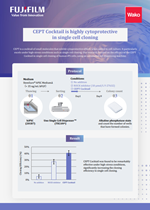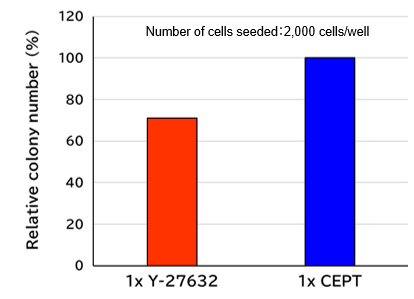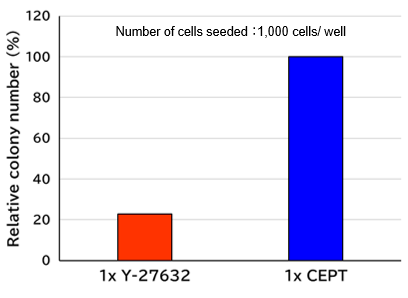CultureSure™ CEPT Cocktail(1,000×)
CEPT is a cocktail of small molecules developed at the National Institutes of Health (NIH). It contains four components, and CEPT is an acronym for them: Chroman 1, Emricasan, Polyamines, and Trans-ISRIB.
In human ES cells and human iPS cells (human pluripotent stem cells [hPSCs]), CEPT prevents cellular stress and DNA damage during cell passage.1) Like Y-27632, a known potent ROCK inhibitor, it improves the viability of hPSCs during cell passage and cryopreservation.
Compared to existing methods, CEPT also improves cell viability in stem cell research, including embryoid body and organoid formation, single cell cloning, and genome editing using hPSCs.1-5)
Our product is a ready-to-use CEPT cocktail solution that has been tested for sterility and does not require preparation. This filter-sterilized solution can be added directly to the culture medium. It will aid in regenerative medicine research.
*This product is manufactured and sold under license from NIH.
Application note - single cell cloning -
Analytical Data
- Concentration (HPLC): Passed
- Appearance: Liquid
- Endotoxin: Less than 3 EU/mL
- Tested for sterility
- Tested for negative mycoplasma contamination
How to Use
Add 1/1,000 volume of this product to the culture medium and mix thoroughly before use.

Precautions for Use
- This product should be stored frozen (-20°C). To avoid repeated freezing and thawing, it is recommended to aliquot in small volumes and freeze.
- When refreezing, store at -80°C, and after confirming that the contents have frozen, store at -20°C.
- Some precipitates may be visible when dissolving. This will not affect the quality of the product, and it can be used as it is.
(It is possible to dissolve the precipitates by incubating at 37°C for 1~2 hours, but repeated freezing and heating should be avoided.)
Samples and Applications
Samples: human ES cells, human iPS cells
Applications:
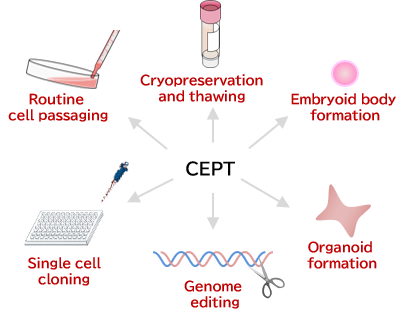
Data
Colony Formation Test
The human iPS cell 201B7 strain was seeded in StemSure® hPSC Medium Δ containing bFGF supplemented with CEPT or Y-27632 at 37°C under 5% CO2 conditions (6-well plates, 1 well= 9.5 cm2).
After at least 16 hours from the start of culture, the medium was replaced with the medium without CEPT or Y-27632, and the culture was continued with media changes every 2 to 3 days.
After checking the cells on day 8, they were fixed with 4% paraformaldehyde, stained with ALP, and colonies were counted.
Single-cell Cloning Test
The human iPS cell 201B7 strain was seeded in StemSure® hPSC Medium Δ containing bFGF supplemented with CEPT or Y-27632 at 37°C under 5% CO2 conditions (96-well plates).
After at least 16 hours from the start of culture, the medium was replaced with the medium without CEPT or Y-27632, and the culture was continued with media changes every 2 to 3 days.
After checking the cells on day 13, they were fixed with 4% paraformaldehyde, stained with ALP, and the number of wells with and without colonies were counted. The colony formation rate was calculated from the number of wells with colonies relative to the total number of wells.
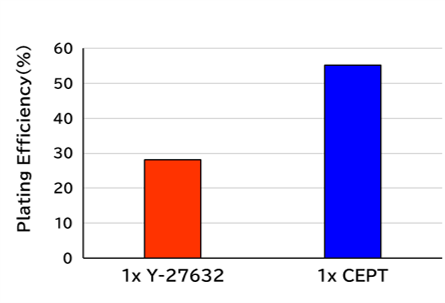
[Result]
When the number of cells seeded was small, more colonies were formed in the CEPT-supplemented cultures than in the Y-27632-supplemented cultures.
Undifferentiated State Maintenance
- Cells: human iPS cell 201B7 strain
- Medium: StemSure® hPSC Medium Δ + 35 ng/mL bFGF
- Red: rBC2LCN-635 (human iPSC membrane stain)
- Blue: DAPI (nuclear stain)
- Note: BC2LCN is a recombinant lectin with high affinity for cell surface glycans of human ES cells and human iPS cells.
-
-
▽With CEPT 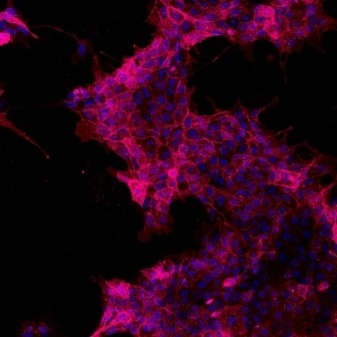
-
▽With Y-27632 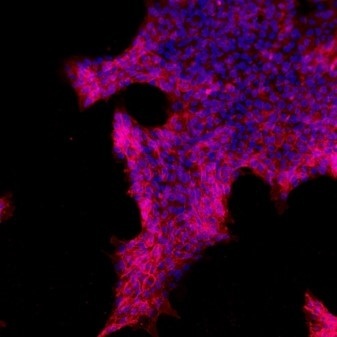
-
[Result]
No difference in cell morphology was observed between the addition of CEPT and Y-27632. The undifferentiated state was also maintained.
Colony Formation Test when Cell Passaging
- Cell strain: Human iPS cell 253G4 strain
- Medium: StemSure® hPSC Medium Δ containing 40 ng/mL bFGF
- Coating: Matrigel® hESC-Qualified Matrix
- Number of seeded cells: 1,000 cells/well(6 well plate)
- Duration of Culture: 7 days
- Additives: Y-27632 or CEPT was added at the time of seeding. Cells were cultured without the addition from the following day onward.
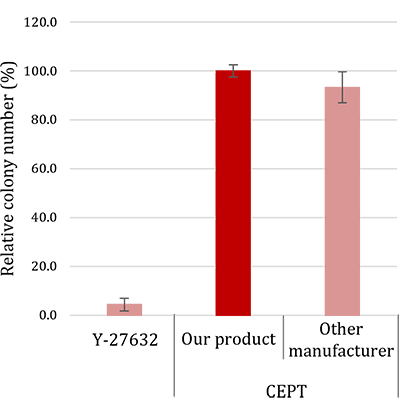
[Result]
Human iPS cells were seeded in Y-27632 or CEPT-supplemented cultures when cell passaging. After 7 days of incubation, more colonies were formed in the CEPT-supplemented cultures than Y-27632. In addition, our product showed the same performance as other manufacturer.
Colony Formation Test when Thawing Frozen Cells
- Cell strain: Human iPS cell 253G4 strain
- Medium: StemSure® hPSC Medium Δ containing 40 ng/mL bFGF
- Coating: Matrigel® hESC-Qualified Matrix
- Number of seeded cells: 1,000 cells/well(6 well plate)
- Duration of Culture: 7 days
- Additives: Y-27632 or CEPT was added at the time of seeding. Cells were cultured without the addition from the following day onward.
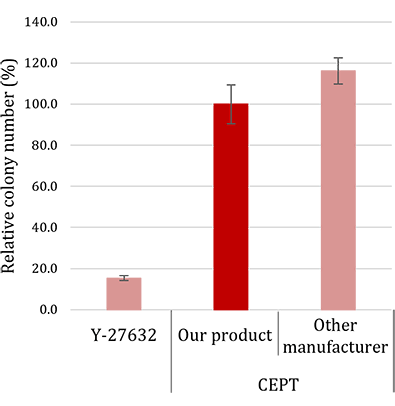
[Result]
Frozen human iPS cells were thawed and seeded in Y-27632 or CEPT-supplemented cultures. After 7 days of incubation, more colonies were formed in the CEPT-supplemented cultures than Y-27632. In addition, our product showed the same performance as other manufacturer.
Efficacy for Single Cell Cloning
Human iPS cells were seeded in each well of the 96-well plate so that they would be single-cells, and after 9 days of incubation, the number of wells that had formed colonies was counted.
- Cell strain: Human iPS cell 201B7 strain
- Medium: StemSure® hPSC Medium Δ containing 35 ng/mL bFGF
- Coating: Matrigel® hESC-Qualified Matrix
- Number of seeded cells: 1 cell/well(96well plate)
- Duration of Culture: 9 days
- Additives: Y-27632 or CEPT was added at the time of seeding. Cells were cultured without the addition from the following day onward.
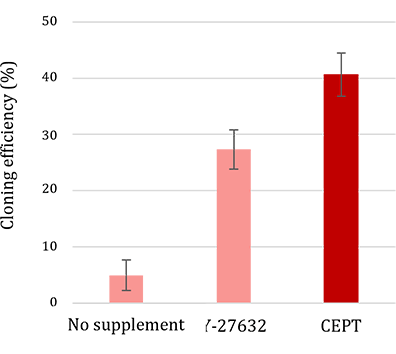
[Result]
CEPT cocktail was shown a remarkable cytoprotective effect under high-stress conditions and significantly increase the cloning efficiency in single-cell cloning.
References
- Chen, Y. et al. : Nat. Methods, 18(5), 528 (2021).
A versatile polypharmacology platform promotes cytoprotection and viability of human pluripotent and differentiated cells. - Tristan, C.A. et al. : Stem Cell Reports, 16(12), 3076 (2021).
Robotic high-throughput biomanufacturing and functional differentiation of human pluripotent stem cells. - Tristan, C.A. et al. : Nat. Protoc., 18(1), 58 (2022).
Efficient and safe single-cell cloning of human pluripotent stem cells using the CEPT cocktail. - Deng, T. et al. : Stem Cell Reports, 18(4), 1030 (2023).
Scalable generation of sensory neurons from human pluripotent stem cells. - Takeshi, W. et al. : Regen. Med., 18(3), 219 (2023).
International evaluation study of a highly efficient culture assay for detection of residual human pluripotent stem cells in cell therapies.
Product List
- Open All
- Close All
For research use or further manufacturing use only. Not for use in diagnostic procedures.
Product content may differ from the actual image due to minor specification changes etc.
If the revision of product standards and packaging standards has been made, there is a case where the actual product specifications and images are different.







